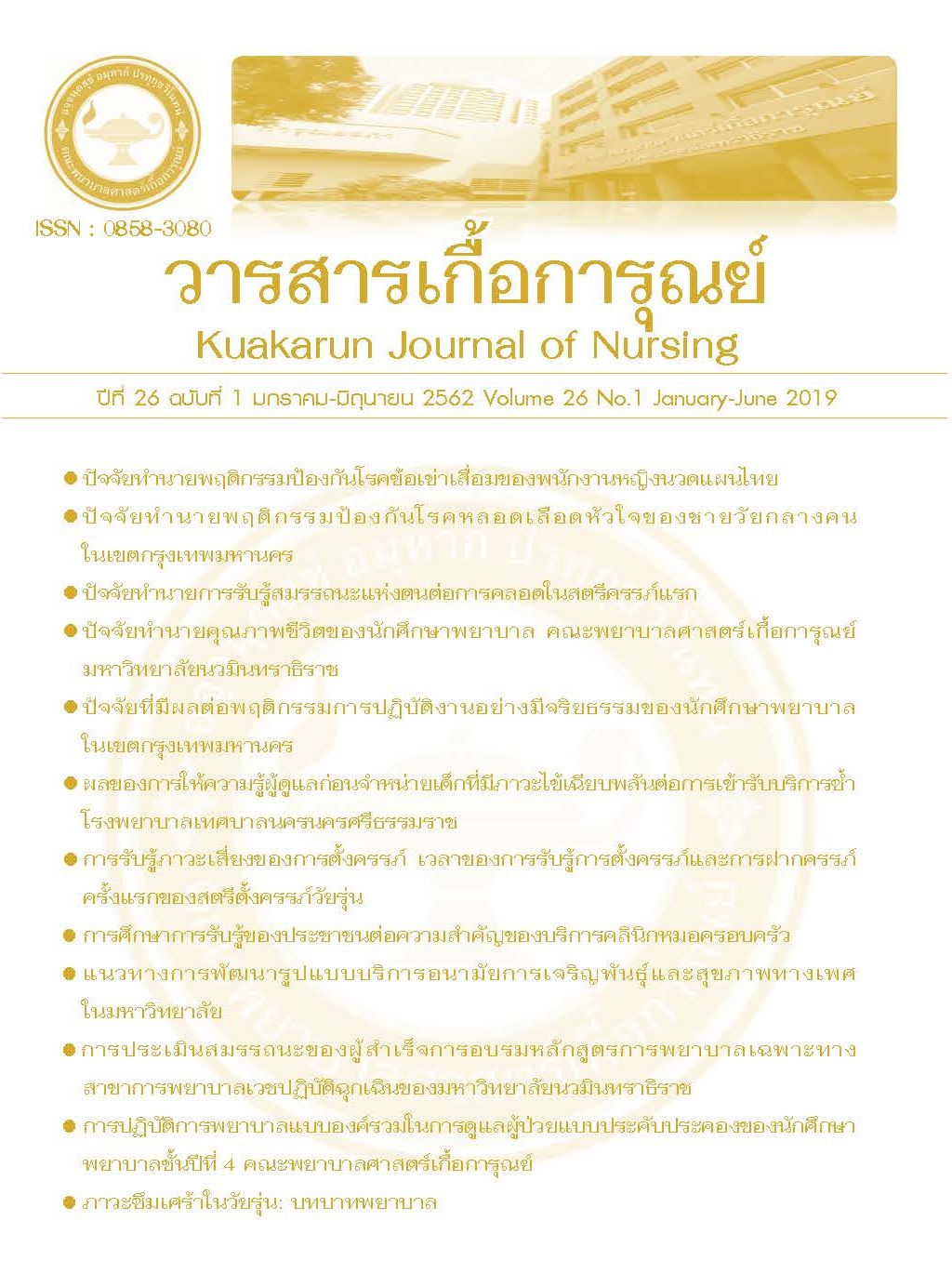ปัจจัยทำนายการรับรู้สมรรถนะแห่งตนต่อการคลอดในสตรีครรภ์แรก
คำสำคัญ:
การรับรู้สมรรถนะแห่งตนต่อการคลอด, สตรีครรภ์แรกบทคัดย่อ
งานวิจัยครั้งนี้มีวัตถุประสงค์เพื่อศึกษาปัจจัยทำนายการรับรู้สมรรถนะแห่งตนต่อการ คลอดในสตรีครรภ์แรก โดยใช้ทฤษฎีการรับรู้สมรรถนะแห่งตนของแบนดูรา (Bandura, 1997) เป็น กรอบแนวคิดการวิจัย กลุ่มตัวอย่างเป็นสตรีครรภ์แรกที่มารับบริการฝากครรภ์ ณ หน่วย ฝากครรภ์ โรงพยาบาลรามาธิบดี ระหว่างเดือน ธันวาคม พ.ศ. 2559 ถึงเดือน มีนาคม พ.ศ. 2560 จำนวน 100 ราย คัดเลือกกลุ่มตัวอย่างแบบเฉพาะเจาะจงตามคุณสมบัติที่ผู้วิจัยกำหนด เครื่องมือที่ใช้ในการวิจัย ประกอบด้วย แบบสอบถามประสบการณ์การจัดการความปวดในระยะตั้งครรภ์ แบบวัดความรู้เกี่ยวกับการคลอด แบบวัดแรงสนับสนุนทางสังคม แบบประเมินความวิตกกังวลในการคลอด แบบประเมินความกลัวการคลอด และแบบประเมินการรับรู้สมรรถนะแห่งตนต่อการคลอด ข้อมูลที่ได้นำมาวิเคราะห์ด้วยสถิติเชิงบรรยาย และสถิติการวิเคราะห์ถดถอยพหุคูณแบบขั้นตอน
ผลการวิจัยพบว่าปัจจัยที่สามารถทำนายการรับรู้สมรรถนะแห่งตนต่อการคลอดในสตรีครรภ์แรก ได้แก่ ความกลัวการคลอด ความวิตกกังวลในการคลอด และแรงสนับสนุนทางสังคม โดยสามารถร่วมกันอธิบายความแปรปรวนของการรับรู้สมรรถนะแห่งตนต่อการคลอดในสตรีครรภ์แรกได้ร้อยละ 37 อย่างมีนัยสำคัญทางสถิติ (p < .05)
ข้อเสนอแนะที่ได้จากการวิจัยครั้งนี้ คือ พยาบาลผดุงครรภ์ควรประเมินปัจจัยต่างๆ ที่มีอิทธิพลต่อการรับรู้สมรรถนะแห่งต้นต่อการคลอด ได้แก่ ความกลัวการคลอด ความวิตกกังวลในการคลอด และแรงสนับสนุนทางสังคม เพื่อนำมาวางแผนการพยาบาลในการส่งเสริมให้สตรีครรภ์แรกมีการรับรู้สมรรถนะแห่งตนต่อการคลอดที่ดี
เอกสารอ้างอิง
2. จิราวรรณ นิรมิตภาษ. (2551). ปัจจัยส่วนบุคคล ความรู้สึกมีคุณค่าในตนเอง แรงสนับสนุนทางสังคม และ การปรับตัวด้านจิตสังคม ของสตรีตั้งครรภ์ที่อายุมาก.วิทยานิพนธ์ปริญญาพยาบาลศาสตรมหาบัณฑิต สาขาวิชาการพยาบาลมารดา และทารกแรกเกิด, บัณฑิตวิทยาลัย, มหาวิทยาลัยมหิดล.
3. ฉวี เบาทรวง. (2526). ผลของการให้คำแนะนำในการปฏิบัติตนอย่างมีแบบแผน และการสัมผัสต่อการลด ความวิตกกังวล และพฤติกรรมการเผชิญภาวะเคียดในระยะคลอด. วิทยานิพนธ์ปริญญาพยาบาลศาสตรมหาบัณฑิต สาขาวิชาการพยาบาลแม่และเด็ก, บัณฑิตวิทยาลัย, มหาวิทยาลัยมหิดล.
4. ประทุมพร เพียรจริง, ละมัย วีระกุล, บุษยา ยารังสี, ผกา สุขเจริญ, และ สุทธิพร พรหมจันทร์. (2544). ผลของโปรแกรมการเตรียมคลอดต่อความรู้และพฤติกรรมการเผชิญความเจ็บปวดในระยะคลอดในมารดาครรภ์แรก. วารสารสภาการพยาบาล, 16(3), 25-36.
5. รัชนันต์ ถิรรดา. (2548). ผลของการใช้โปรแกรมการเตรียมคลอด ต่อความรู้เกี่ยวกับการคลอดพฤติกรรม การเผชิญความเจ็บปวดในระยะคลอดและความพึงพอใจต่อการใช้บริการคลอดของมารดาครรภ์แรก. วารสารคณะพยาบาลศาสตร์ มหาวิทยาลัยบูรพา, 13(3), 10-12.
6. Attanasio, L. B., McPherson, M. E., & Kozhimannil, K. B. (2014). Positive childbirth experiences in U.S. hospitals: A mixed methods analysis. Maternal and Child Health Journal, 18(5), 1280-1290. doi:10.1007/s10995-013-1363-1
7. Bandura A. (1977). Self-efficacy: Toward a unifying theory of behavioral change. Psychological Review,84(2), 191-215.
8. Bandura A. (1997). Self-efficacy: The exercise of control. New York: W.H. Freeman.
9. Beebe, K. R., Lee, K. A., Carrieri-Kohlman, V., & Humphreys, J. (2007). The effects of childbirth self- efficacy and anxiety during pregnancy on prehospitalization labor. Journal of Obstetric, Gynecologic, & Neonatal Nursing, 36(5), 410-418. doi:10.1111/j.1552-6909.2007.00170.x
10. Bryanton, J., Gagnon, A. J., Johnston, C., & Hatem, M. (2008). Predictors of women's perceptions of the childbirth experience. Journal of Obstetric, Gynecologic, & Neonatal Nursing, 37(1), 24-34. doi:10.1111/j.1552-6909.2007.00203.x
11. Byrne, J., Hauck, Y., Fisher, C., Bayes, S., & Schutze, R. (2014). Effectiveness of a mindfulness-based childbirth education pilot study on maternal self-efficacy and fear of childbirth. Journal of Midwifery & Women's Health, 59(2), 192-197. doi:10.1111/jmwh.12075
12. Cheung, W., Ip, W. Y., & Chan, D. (2007). Maternal anxiety and feelings of control during labour: A study of Chinese first-time pregnant women. Midwifery, 23(2), 123-130. doi:10.1016/j.midw.2006.05.001
13. Christiaens, W., & Bracke, P. (2007). Assessment of social psychological determinants of satisfaction with childbirth in a cross-national perspective. Bio Med Central Pregnancy Childbirth, 7(26), 1-12. doi:10.1186/1471-2393-7-26
14. Cohen, J. (1988), Statistical power analysis for the behavioral sciences (2nd ed.). Hillsdale, N.J.: Lawrence Erlbaum.
15. Garthus-Niegel, S., Storksen, H. T., Torgersen, L., Soest, T. V., & Eberhard-Gran, M. (2011). The Wijma Delivery Expectancy/Experience Questionnaire: A factor analytic study. Journal of Psychosomatic Obstetrics & Gynecology, 32(3), 160-163. doi:10.3109/0167482x.2011.573110
16. Gibbins, J., & Thomson, A. M. (2001). Women's expectations and experiences of childbirth. Midwifery, 17(4), 302-313. doi:https://dx.doi.org/10.1054/midw.2001.0263
17. Goodman, P., Mackey, M. C., & Tavakoli, A. S. (2004). Factors related to childbirth satisfaction. Journal of Advanced Nursing, 46(2), 212-219. doi:10.1111/j.1365-2648.2003.02981.x
18. House, J. S. (1981). Work stress and social support. Reading, MA: Addison-Wesley.
19. Ip, W. Y., Tang, C. S., & Goggins, W. B. (2009). An educational intervention to improve women's ability to cope with childbirth. Journal of Clinical Nursing, 18(15), 2125-2135. doi:10.1111/j.1365- 2702.2008.02720.x
20. Iravani, M., Zarean, E., Janghorbani, M., & Bahrami, M. (2015). Women's needs and expectations during normal labor and delivery. Journal of Education and Health Promotion, 4, 6. doi:10.4103/2277-9531.151885
21. Khaikin, R., Marcus, Y., Kelishek, S., & Balik C. (2016). The effect of childbirth preparation courses on anxiety and self-efficacy in coping with childbirth. Sciedu Press, 4(3), 39-46.
22. Lowe, N. K. (1991). Maternal confidence in coping with labor: A self-efficacy concept. Journal of Obstetric, Gynecologic, & Neonatal Nursing, 20(6), 457-463.
23. Lowe, N. K. (1993). Maternal confidence for labor: Development of the Childbirth Self-Efficacy Inventory. Research in Nursing & Health, 16(2), 141-149.
24. Lowe, N. K. (2000). Self-efficacy for labor and childbirth fears in nulliparous pregnant women. Journal of psychosomatic obstetrics and gynaecology, 21(4), 219-224.
25. Madhavanprabhakaran, G. K., D’Souza, M. S., & Nairy, K. (2016). Effectiveness of childbirth education on nulliparous women’s knowledge of childbirth preparation, pregnancy anxiety and pregnancy outcomes. Nursing and Midwifery Studies, e32526. doi: 10.17795/nmsjournal32526
26. Salehi, A., Fahami, F., & Beigi, M. (2016). The effect of presence of trained husbands beside their wives during childbirth on women’s anxiety. Iranian Journal of Nursing and Midwifery Research, 21(6), 611-615. https://doi.org/10.4103/1735-9066.197672
27. Salomonsson, B., Gullberg, M. T., Alehagen, S., & Wijma, K. (2013). Self-efficacy beliefs and fear of childbirth in nulliparous women. Journal of Psychosomatic Obstetrics & Gynecology, 34(3), 116-121. doi:10.3109/0167482x.2013.824418
28. Schwartz, L., Toohill, J., Creedy, D. K., Baird, K., Gamble, J., & Fenwick, J. (2015). Factors associated with childbirth self-efficacy in Australian childbearing women. Bio Med Central Pregnancy Childbirth, 15(29), 1-29. doi:10.1186/s12884-015-0465-8
29. Sercekus, P., & Baskale, H. (2016). Effects of antenatal education on fear of childbirth, maternal self- efficacy and parental attachment. Midwifery, 34, 166-172. doi:10.1016/j.midw.2015.11.016
30. Spielberger, C. D., Gorsuch, R. L., Lushene, R., Vagg, P. R., & Jacobs, G. A. (1983). Manual for the State-Trait Anxiety Inventory. Palo Alto, CA: Consulting Psychologists Press.
31. Taheri, Z., Mazaheri, M. A., Khorsandi, M., Hassanzadeh, A., & Amiri, M. (2014). Effect of educational intervention on self-efficacy for choosing delivery method among pregnant women in 2013. International journal of preventive medicine, 5(10), 1247-1254.
32. Tanglakmankhong, K. (2010). Childbirth expectations and childbirth experience among Thai pregnant women (Unpublished doctoral dissertation). Oregon Health & Science University School of Nursing, Portland, U.S.A.
33. Toohill, J., Fenwick, J., Gamble, J., Creedy, D. K., Buist, A., & Ryding, E. L. (2014). Psycho-social predictors of childbirth fear in pregnant women: An Australian study. Journal of Obstetrics and Gynecology, 4, 531-543. doi:10.4236/ojog.2014.49075
34. Toohill, J., Fenwick, J., Gamble, J., Creedy, D. K., Buist, A., Turkstra, E., & Ryding, E. L. (2014). A randomized controlled trial of a psycho-education intervention by midwives in reducing childbirth fear in pregnant women. Birth, 41(4), 384-394. doi:10.1111/birt.12136















